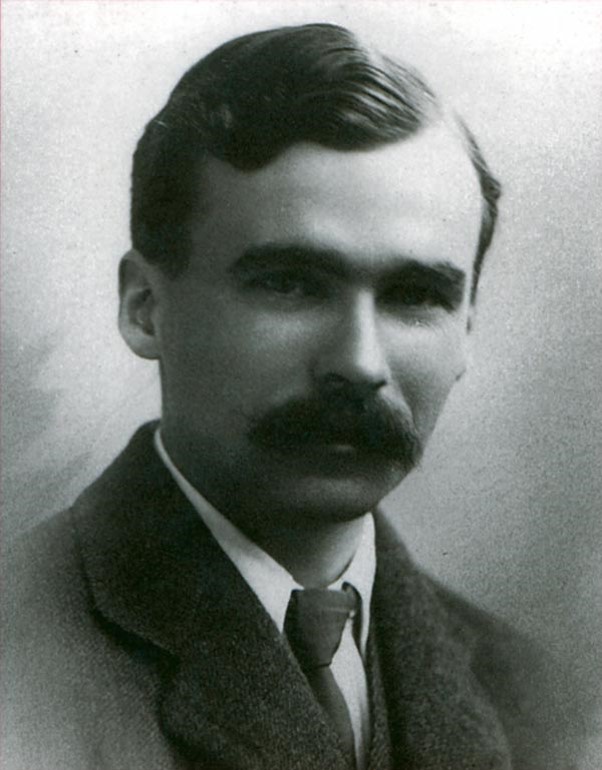
At the outbreak of the First World War, George Butterworth was being described as the most promising British composer of his day.
George was born in Paddington, London in 1885 but at the age of six moved to Yorkshire when his father became first solicitor and then General Manager of the North Eastern Railway Company. George inherited his mother’s talent for music (she was a professional singer before her marriage). His parents sent him to Aysgarth Preparatory School, near Bedale where he played the organ during school services. His musical ability led to him gaining an Organ Scholarship to Eton College. He initally entered Trinity College, Oxford with the intention of studying law, but this idea was abandoned as he became increasingly interested in setting down the folk music of the British Isles.
At the outbreak of the First World War, George enlisted in the Duke of Cornwall’s Light Infantry and was later granted a commission in the Durham Light Infantry. He was on active service for almost a year and awarded the Military Cross in 1917. The citation states that he had commanded the Company when the Captain was wounded ‘with great ability and coolness … and total disregard of personal safety’.
Less than a month later, on Saturday 5 August, he was shot through the head by a German sniper in ‘Munster Alley’. Only a day later, William Short of the 8th Battalion, Yorkshire Regiment undertook the action which led to his posthumous Victoria Cross in the same spot.
In his letter of condolence to the Butterworth family dated 13 August, his commanding officer, who had been visiting the company moments before the fatal shot, wrote that George was ‘one of those quiet, unassuming men whose path did not appear naturally to be a military one, … [but he had done his duty] … quietly and conscientiously. When the offensive came he seemed to throw off his reserve and, in those strenuous 35 days in which we were fighting off and on, he developed a power of leadership which we had not realised he possessed.’ He was in charge of a group digging a trench under German fire – this trench was subsequently called the Butterworth Trench on all the official maps – and he was ‘cheery and inspiring his tired men to secure the position which had been won earlier in the night…. Within a minute of my leaving him, he was shot.’
His body was never recovered although it is thought that it might have been interred at the nearby Pozieres Memorial Commonwealth War Graves Commission cemetery. George’s name is displayed on the Thiepval Memorial to the Missing of the Battles of the Somme. This memorial is near the village of Thiepval in Picardy, France, and commemorates the 72,195 missing British and South African men with no known grave.
Explore more memories from the ribbon
-
Sapper Joseph William Colling
William Colling – Sunderland Joseph William Colling was the father of Brenda Crinall of Little Crakehall, who called in at the museum with a friend who wanted to contribute a story to the Ribbon of Rememberance. Brenda didn’t really know a great deal about her father’s participation in the war, but was interested when we offered to take a look and see if any records still existed from that time. As fortune would have it, her father’s service record was available to see and so we were able to piece together some of his experiences from the time of the First World War. Before enlisting Colling worked as a sorting clerk and telegraphist for the G.P.O. in Sunderland. Prior to going to German East Africa (G.E.A.) in 1916 he served for 13 months in France. Some of the most dangerous activities he undertook was to lay cables as close to the enemy lines as possible. These cables were essential for information and orders to be relayed to and from the battlefront. In 1916 the German plan for war in G.E.A. was to divert Allied forces away from the Western Front in Europe. Colling sailed from Devonport on the 8th of February 1916 and he arrived in Durban on the 6th of March.On the 14th of March he arrived at Kildini inlet near Mombassa. Over the next few months he and his comrades came under heavy attack several times as they advanced south towards German forces.This included fierce action near Kilosa….
-
Fred Shaw
Fred, the fourth child of five to Ned and Ann Shaw, was born around 1884 at Slaithwaite near Huddersfield. His father Ned was a railway signal man and part time photographer. Two of Fred’s brothers would emigrate to Canada before the Great War began. Fred trained as a journeyman tailor and travelled to seek employment. Whilst in the Hawes district he met and married a girl from Hawes, Mary Elizabeth Blades, in November 1909. Fred enlisted in Hawes in June 1916, joining the 9th Battalion Yorkshire Regiment. Fred went to France in September 1916. Private Fred Shaw was killed on the first day of The Battle of Messines on the 7th June 1917 aged 33. Fred’s body was never found and his name is commemorated on the Menin Gate at Ypres. Sadly, just four and a half months after his father died, their son Jimmy died aged 5.
-
4/7766 Private Thomas Holmes
Mary Burn visited the Green Howards Museum to tell us about her father’s cousin, Thomas Holmes. Prior to the outbreak of the First World War, Thomas Holmes worked for Mr Gaffanney, a coal dealer in Leeds. As a reservist, he was called up on the outbreak of War to the 9th Battalion, the West Yorkshire Regiment while his brother served with the 1st Scots Guards. At only 19 years of age, Private Holmes was sent to Gallipoli. One of the thousands to die at Suvla Bay, he was killed on 29th October 1915 and is buried at Hill 10 cemetery along with 548 other casualties.
